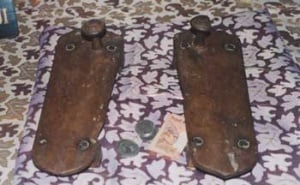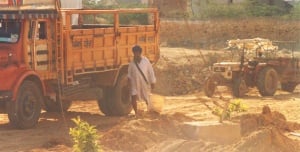Gurdwara Lakhpat Sahib
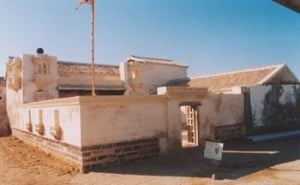
Gurdwara Pehli Patshahi meaning the "Gurdwara of the first master" is situated at Lakhpat, Gujarat, India - A town in Gujarat, visited by Guru Nanak Sahib during his second and fourth missionary journeys (Udasis) in 1506-1513 AD and 1519-1521 AD respectively. Gurdwara Guru Nanak Sahib has been built to preserve the memory of these visits of revered Guru during the early 1500s. Guru Nanak is believed to have visited this site while he was on his way to Mecca during the Fourth Udasi. A few rare personal possessions of his are retained here.
In the course of Guru Nanak Dev ji's travels, he visited Gujarat and traveled on to Lakhpat. In old times, Lakhpat was part of Sind (now in Pakistan). Lakhpat is 170 kms from Gandhidham, Gujarat, India. In the sixteenth century Lakhpat was known as "Basta Bander". Lakhpat used to be a rich rice growing area and was also a popular port. However, due to an earthquake in 1819 A.D., the area became barren and crops withered away due to a lack of water as the river disappeared after the earthquake.
To commemorate Guru Nanak Dev ji's visit to Lakhpat, a Gurudwara was built in the early years of the nineteenth century. A vast tract of land was bestowed to the Gurudwara to make up expenses for maintenance and to look after the visitors. The revenues from the land and the crops grown there have sustained the Gurdwara. Lakhpat is about 20 kms from Korini village where there is a big Sarovar in memory of the visit by Guru Nanak Dev ji to this area. From Lakhpat, Guru ji crossed to Somiani port in Sind for his famous journey onward to Mecca and Medina in Saudi Arabia.
Gurdwara Sahib
Although a Gurdwara has stood here since the 1800s, in the later part of twentieth century, some Sikh families settled near Lakhpat and in other parts of Kutch, particukar at Gandhidham. This was the port-city of Kandla port, which was built in the year 1952. In the wake of independence of India in 1947, lot of Sindhi's families settled in Kutch from erstwhile Sind Province. Sindhi's have been devotees of Guru Nanak Dev. They with the co-operation of the Sikh's built a Gurudwara at Gandhidham and this Gurudwara management along with a Sindhi fellow settled at Lakhpat after independence. They have been looking after the Lakhpat shrine for the last 50 years.
It is believed that Guru Nanak Dev ji stayed at Lakhpat several times during his trips to Mecca and Medina (Saudi Arabia). The place served as a seat of the Udasi Sect. Several rare treasures are preserved at Gurudwara Shri Lakhpat Sahib, including the "charan Paduka" - Khadvas (wooden footwear) that belonged to Guru Nanak Dev ji.
At present various extensions are being added to the Gurdwara complex and this "sewa" of additional building of Yatri Niwas (visitor's sleeping rooms), Langar hall (Dining hall), Diwan Hall (congregation hall) is being undertaken by Shri Baba Lakkha Singh ji - Baruch.
Kar Seva
- Kar Sewa Sach Khand wasi brham Gyani Shri Mann Sant Baba Tara Singh ji Sarehali Sahib wale
- Sant Baba Lakha Singh ji
- Sant Baba Balkar Singh ji
- Sant Baba Balvinder singh ji
- Sant Baba Harjit Singh ji
- Sant Baba Jassa Singh ji
UNESCO Award to Gurudwara
For the people of Lakhpat, Kutch, there was a reason to celebrate. The Gurudwara has bagged the UNESCO Asia-Pacific Heritage Conservation Award for the year 2004. The award comprises a scroll and a trophy which goes to CRCI (Cultural Resources Conservation Initiative).
The Archaeological Survey of India, the State Department of Archaeology. United Nations Development Programme and United Nations Volunteers supported the Conservation programme which took seven months for restoration, as the Gurudwara was damaged during 1998 cyclone in Gujarat and the January 2001 earthquake in Gujarat.
The government of Gujarat undertook the conservation and reconstruction of the 200-year-old gurdwara at Lakhpat in Kutch district after it was damaged during the 2001 earthquake.
"Impressed by the efforts, UNESCO has conferred the UNESCO Asia-Pacific Heritage Award to the Lakhpat gurdwara and thereby appreciated the state government," an official release said.
The cultural activities department had taken up reconstruction of the gurdwara through people's participation. The project received a grant from the Archaeological Survey of India and had the cooperation of the United Nations Volunteer Programme.
Conferring the award, UNESCO stated, "The restoration of this Sikh house of worship demonstrates a sophisticated holistic understanding of both the technical and social aspects of conservation.
"Careful attention to detail and sensitive repair work have ensured the retention of the building's historic character. The emphasis on involving and empowering the community ensures the long-term survival of the historic building and its associated cultural traditions."
Contact
SBI Dayapar, Taluka Lakhpat
Dist : Kutch (Bhuj), BrCode 6279
Acct no : 01190007746
Baba Harjit Singh ji Saving A/C
Kar Sewa Shri Guru Nanak Dabar Lakhpat.
Phone : 02839-233338
Fax : 02839-2333395
Also
Kiran Singh Kochar
email: [email protected]
Phone: + 91 942 691 6098 or 997 891 6098.
Quote from UNESCO, Bangkok
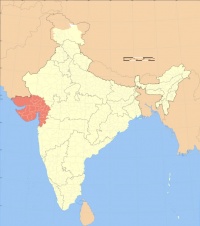
- Project Title: Lakhpat Gurudwara
- Date of Completion: September 2003
- Location: Lakhpat Village, Kuchchh District, Gujarat, India
- Size: 4028 square feet
- Costs: US$43,200
- Client: Shri Guru Nanak Education Society, Gandhidham, Kar Sewa Gurudwara Chandar Sahib, Patshahi Pahili, Bharuch, Gujarat
- Heritage Architect: Cultural Resources Conservation Initiative (CRCI)
- Contractor: Cultural Resources Conservation Initiative (CRCI)
- Context: Physical, Social, Legal
The Lakhpat Gurudwara is an active place of Sikh worship and is frequently visited by tourists and pilgrims. Lakhpat, a prosperous port town and trade centre until the early 19th century, is one of the most significant historic settlements of the region. There are numerous historic sites associated with saints of different religions within the walls of this fortified settlement. The Gurudwara itself dates to the nineteenth century.
The significance of the Gurudwara lies in its association with the Udasi sect, believed to be the oldest Sikh order. It is also believed (although factually not correct) that Guru Nanak Dev, founder of the Sikh religion, visited the site in the sixteenth century en route to Mecca. It houses relics such as a decoratively carved wooden cradle, wooden sandals that are believed to have belonged to Guru Nanak Dev, manuscripts and markings of two of the important heads of the Udasi sect.
Initially, the caretakers of the site were drawn from the Udasi sect. Later, the Sikh community from the Gurudwara Nanak Singh Sabha in the nearby port town of Gandhidham started taking care of the site. Religious functions were organized periodically to ensure the continuity of religious rituals and to keep the historic importance and religious sanctity of the place alive.
The Gurudwara complex is comprised of a main building, which has a courtyard, and a separate structure that is a gateway. This gateway, located on the western side of the complex, is a double storey building with a large pointed arch entrance and massive wooden doors. The courtyard, which precedes the main building, is accessed through a low gateway along the eastern side. The main building is a double storey building. The ground floor comprises two rooms with a long verandah that is parallel to its courtyard edge. A wooden staircase leads from the verandah to the terrace above it. There is a one room, one storey structure adjoining the main building at a right angle, creating an L shape design along two sides of the courtyard.
Built with locally available limestone and red sandstone laid in lime mortar and plastered with a fine coat of lime plaster, the external walls are decorated with projecting carved stone balconies and perforated panels. The roofs are sloping with a horizontal timber ridge beam at the apex and wooden purloins supporting the common rafters, and covered with bamboo strips, mud mortar and tiles.
The internal and external walls have paintings in line pattern with floral motifs around the openings and select areas of the walls. The largest room in the main building houses an elaborately decorated wooden swing with polychrome floral paintings on its surface and the verandahs have intricately carved wooden columns. Other decorative features are stone sculptures in human and animal forms fixed in the stone masonry.
The Gurudwara was declared a "protected monument" in 1992 under the "Gujarat Ancient Monuments and Archeological Sites and Remains Act". It is maintained by a trust fund established through the contributions of the Sikh community, both local and regional.
Today the settlement at Lakhpat has a population of around 400, with the majority being Muslims. The Sikh community constitutes a very small segment in the region. The people in Lakhpat, irrespective of their religious backgrounds, are a very closely-knit community. With the recently increased communal tensions in Gujarat in mind, the restoration project was viewed as one way to attenuate the region’s religious tension by encouraging participation of various communities in the conservation of the sacred site of "the other".
Building History
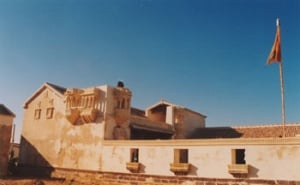
Due to adverse climatic conditions, the monument had experienced immense physical deterioration prior to restoration. Seepage of water and the high salt content in the air caused deterioration in the plaster, timber and masonry.
Previous repairs on the building had used inappropriate and incompatible materials like cement based plasters and concrete on the walls and floors which trapped moisture and accelerated the deterioration rate of the building. Inappropriate surface finishes also included multiple coats of lime wash which covered wall paintings, enamel paint on the woodwork of ceilings, doors, windows and other decorative elements. These incongruous additions also contributed to the loss of authenticity of the historic structure.
Externally, the open ground surrounding the building had been inappropriately landscaped with vegetation growth along the walls causing dampness. Accumulation of rainwater occurred along the main access making it unapproachable during the rainy season.
As Kuchchh is an area susceptible to natural disasters, the Gurudwara had also developed structural cracks due to the impact from earthquakes and cyclones.
Project History
The Sikh community based in Gandhidham, a significant port town in Kuchchh, approached the Cultural Resources Conservation Initiative (CRCI), New Delhi to assist in the conservation of the historic Gurudwara. Being a protected monument, the community was unable to get permission for its repair work from the State Department of Archaeology. Additionally, the State had no plans or budgetary allocation for its conservation. It was hoped that by working with CRCI, the project would become a possibility.
CRCI visited the site in 2001 and prepared a project proposal for the conservation of the building which they submitted to the Archaeology Survey of India (ASI) for funding. Due to the immense loss of heritage in the region in the wake of natural disasters the ASI undertook the funding of the project.
The project was further supported by the United Nations Volunteers Program of the UNDP, who provided conservation architects as volunteers for the project as part of their commitment to work for the conservation of cultural heritage.
The conservation work began in February 2003 and was completed in September 2003.
Conservation Methodology and Materials
Sensitive restoration was the motto of the project. Before commencing conservation, the whole building was extensively documented by conservation architects by making measured drawings, undertaking condition assessment and thorough photo documentation.
In the conservation strategy, the emphasis was on removing all inappropriate additions and alterations, especially those that had an adverse effect on the building structurally and aesthetically. The removal of cement plaster and concrete from the walls and floors enabled the building to dry out as the cement layer had led to dampness being trapped within the walls and floors. Multiple layers of lime wash were also removed to reveal fine masonry work. The walls were then prepared for re-plastering, this time with more appropriate lime plaster. The floors were also redone in lime plaster.
Removal of enamel paint was an extensive task and this was carefully done to wooden doors, pillars and stone sculptures. The wooden swing, an invaluable artifact of the Gurudwara, was restored to its original state revealing, beneath the paint, its lacquered surface with floral paintwork. Concrete in-fill within the wooden door and windows in the main building was also removed.
Wherever possible, deteriorated elements were repaired rather than replaced. Original elements affected were mainly of limestone and sandstone. Where this was not possible, the deteriorated elements were replaced using material that was same as the original in color, texture and other visual and physical aspects. Elements that had lost their original features due to severe deterioration had only their form replicated.
Most of the materials were sourced locally. A work yard was established with a slaking pit and mortar mill to make lime mortar with slaked lime, locally available small shell aggregate, coarse and fine sand, using a tractor to pull the stone grinding wheel made of local sandstone.
The grounds were adequately sloped to prevent the accumulation of water at the base of the building and to ensure that the water would drain away from the building.
It was recognized that some modern amenities had to be put in place, and a new electrical layout was put in place for adequate lighting.
Important Issues:
Mobilizing resources and people
One of the key objectives of the program was to encourage the participation of the local community in the conservation process. With mitigation of religious tension in mind, the conservation process was guided by the underlying principle of ensuring participation of various communities in the conservation of the sacred site "of the other" - a notion which carries great meaning in this region, especially in this day and age.
The process also included training the local people, skilled, semi-skilled, and unskilled, in traditional materials and construction techniques which had been lost in this region. Lime, which is very different from cement, required very special handling on the site, and the emphasis was on training them in working with lime in the preparation of lime mortar, plaster and grouting mixture. They were also trained in conservation techniques like raking, cleaning of masonry for pointing, lime wash removal, paint removal, etc.
Most of the trainees were primary school educated and unskilled (without any past experience in conservation work). Their enthusiasm and dedication played a key role in the success of the project among the local community. They also benefited economically as they were employed for the duration of the project. Their newly acquired skills would also be a source of income for them in the future.
Sharing of human resources from various regions was enabled through the project. The team of conservation architects came from Delhi, masons, skilled in particular techniques were called in from as far as Punjab, Rajasthan and Madhya Pradesh. In addition, local craftsmen who still practiced traditional techniques of building construction were identified to assist in the restoration work, especially of the roof and stonework. Their stay and work in Lakphat was a learning work experience for all, and the project became a platform for sharing ideas, experiences and demonstration of skills.
Kar sewaks (volunteers for community work drawn by the religious practice of sewa, or voluntary labour) came from neighbouring and distant places in the region and contributed significantly to the restoration work. A community kitchen was run by a small group of them for the team working on site. At the same time they shared their views on the work being undertaken. It helped the conservation team to understand the requirements of the community at large.
Materials for the conservation work were mostly sourced locally. The project team realized the importance of sourcing local building materials. In addition to making the project that much more economical, using materials available locally also ensured that the community would be able to replicate conservation work and building activity in the future. Thus, information was sought from the people on local resources that could be used for the construction work.
Determining appropriate reuse
In addition to its continued use as a place of worship, the Gurudwara Trust members have proposed using one of the rooms as an exhibition space for the interpretation of the site. The space will house the old relics including an early 19th century Guru Granth Sahib (holy book of the Sikh community) which, prior to the restoration, was housed in Gandhidham.
Lessons learned
This project demonstrates how 'conservation for and by the people' can make a positive difference to their living environment. It was instrumental in bringing together the people of the village and the Sikh community to work for the cause of safeguarding their common heritage.
This project further demonstrates the methodology to enable constructive dialogue and thereby motivate participation of traditional institutions and the local community in safeguarding their own heritage of which they are the caretakers.
Project Sustainability and Viability
The conservation sought to bring out the association of the people to their common heritage through socio-cultural and religious interaction.
This was largely successful and the local people's effort in this conservation project prompted a sense of belonging to the historic building and an awareness of their responsibility towards safeguarding it and other similar sites in the settlement.
The use of locally available materials has ensured that future repairs and restoration work will be easily replicated and will be economically viable for the community. The training of locals in conservation principles and traditional skills has also guaranteed the availability of human capital for future work.
Project Impact
Through discussions about the conservation work, the craftsmen understood how to distinguish between interventions in historic buildings from other modern building activity. The disadvantages of cement as a medium of repair on historic buildings were also discussed and the understanding of lime work was enhanced. Training in the use of traditional material in construction work was an opportunity for the local youth to acquire new skills.
The project also contributed significantly towards the creation of a platform for constructive dialogue between the various stakeholders of the site. These included the local people, the local and regional Sikh community, the kar sewaks, the State Department of Archaeology, and the Archaeological Survey of India. It helped the members of the community to understand conservation standards and techniques better, while making the government departments more sensitive about the requirements and expectations of the local community. It is hoped that this platform will continue to exist beyond the project and be used to discuss future development activities.
The removal of lime wash from the walls revealed historical elements that enhanced the understanding of the evolution of the region’s heritage. Ancient ‘graffiti’ inscribed by travelers who visited the Gurudwara in the past showed the development of the Gurumukhi script (used primarily in the writing of the Punjabi language). Floral line paintings were also revealed as part of the vernacular architectural tradition.
